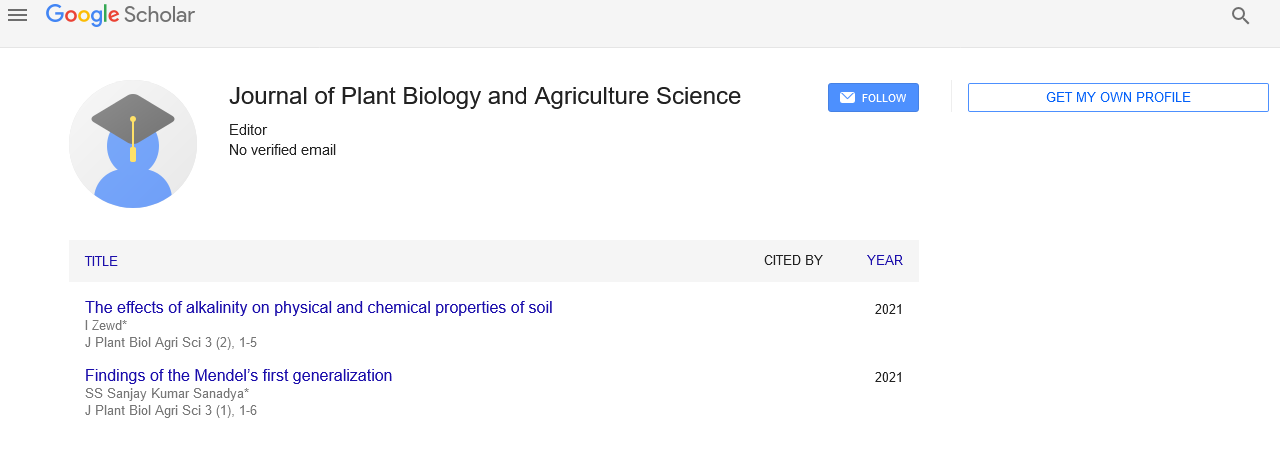Strategies for pest control and its uses
Received: 05-Jul-2022, Manuscript No. puljpbas-22-5695; Editor assigned: 07-Jul-2022, Pre QC No. puljpbas-22-5695(PQ); Accepted Date: Aug 01, 2022; Reviewed: 19-Jul-2022 QC No. puljpbas-22-5695(Q); Revised: 26-Jul-2022, Manuscript No. puljpbas-22-5695(R); Published: 03-Aug-2022, DOI: 10.37532/puljpbas.2022.4(4).1-2.
Citation: Wilson K. Strategies for pest control and its uses J Plant Biol Agric Sci. 2022;4(4):1-2.
This open-access article is distributed under the terms of the Creative Commons Attribution Non-Commercial License (CC BY-NC) (http://creativecommons.org/licenses/by-nc/4.0/), which permits reuse, distribution and reproduction of the article, provided that the original work is properly cited and the reuse is restricted to noncommercial purposes. For commercial reuse, contact reprints@pulsus.com
Abstract
Using pest control techniques, the management of a species known as a bug, a member of the animal kingdom that negatively affects human activities, is referred to as bug control. The human response varies depending on the severity of the suffering caused and might range from resilience through discouragement and management to attempts to completely eradicate the problem. The implementation of bother control measures might be a part of a coordinated bother management strategy. In farming, social, chemical, and organic methods are used to keep bugs at the entrance. There is an advanced trend to limit the use of pesticides as much as is practical, and soil improvement and furrowing during recent sowing reduce the nuisance burden.
Introduction
Natural means are used whenever possible, enabling the bugs natural enemies and supplying suitable predators or parasites. In houses and urban settings, the bothers are the rodents, avian creatures, creepy crawlies, and other living things that share the environment with people and both enhance and undermine a sense of belonging. These annoyances are attempted to be under control by physical restraint, pharmacological means, shock, or restriction. However, several natural control methods, such as sanitization campaigns, can be used.
control methods
Biological pest control - Using other species to control pests, such as creepy crawlies and bugs, is known as organic bug control. Predation, parasitism, herbivory, parasitody, or other common tools are used in its development, but it frequently also incorporates a dynamic human management component. The presentation of the bug's natural enemies, which are cultivated inside the research centre and released into the environment, is a traditional natural control method. Expanding the typical enemies that occur in a particular area by discharging more, either in small, repeated clumps or in a single large-scale discharge, is an optional strategy. In an ideal scenario, the released life form would reproduce, live, and exert long-term control. For instance, the bacterium Bacillus thuringiensis ssp. israelensis, which contaminates and kills mosquito hatchlings, is widely used to manage mosquito populations.
Cultural control- Mechanical bug control is the utilize of hands-on strategies as well as basic hardware and gadgets, that gives a defensive obstruction between plants and creepy crawlies. This can be alluded to as culturing and is one of the most seasoned strategies of weed control as well as being valuable for bug control; wireworms, the hatchlings of the common press insect, are exceptionally dangerous bugs of recently furrowed prairie, and rehashed development uncovered them to the winged creatures and other predators that nourish on them. Crop revolution can offer assistance to control bugs by depriving them of their have plants. It could be a major strategy within the control of corn rootworm, and has decreased early season rate of Colorado potato insect by as much as 95%.
Catch cropping - An edit of a plant that attracts pests and diverts them away from nearby crops is known as a trap edit. Pesticides or other techniques can be used to control bothers more successfully if they concentrate on the trap trim. However, trap-cropping has frequently failed to reduce bug densities on large commercial scales without the use of pesticides, perhaps as a result of the pests' ability to disperse back into the most field.
Pesticides - Pesticides are applied to fields using agrarian flying machines, sprayers mounted on tractors, advanced airships, airborne splash, or seed coatings to suppress insects. In any event, effective pest control by pesticides is not straightforward; appropriate details must be picked, regular time is fundamental, the application technique is crucial, and adequate scope and upkeep on the trim are important. It is advisable to avoid killing the target bother's typical enemies. This is especially important in countries where there are vast supplies of insects and the predators of those insects on the farmland surrounding agricultural crops, and these coexist in a precarious balance. In less developed countries, crops are frequently well adapted to the local environment, negating the need for pesticides. Dynamic ranchers frequently use fertilizers to create advanced crop varieties, which are frequently more resistant to insect damage, but the unexpected application of pesticides may be troublesome in the long run.
Conclusion
Pesticides are used to control a wide range of pests and disease carriers, including rats, mice, ticks, and mosquitoes. In agriculture, pesticides are used to manage weeds, insect infestations, and disease. Pesticides come in a wide variety of forms, and each is designed to be efficient against a particular insect. Several instances include: Algaecides are used to kill algae or to retard their growth. Antimicrobials to combat bacteria, viruses, and other microorganisms. Disinfectants to eliminate bacteria, viruses, and other microorganisms. Fungicides to combat fungi that cause rust, mould, and mildew. Herbicides to eradicate or stop the development of undesirable plants, generally known as weeds. Controlling insects with insecticides. To prevent insect growth and reproduction, use insect growth regulators. the use of rodenticides to eradicate rodents such as mice, rats, gophers, etc. Wood Preservatives help protect wood from pests like fungi, insects, and rodents.





